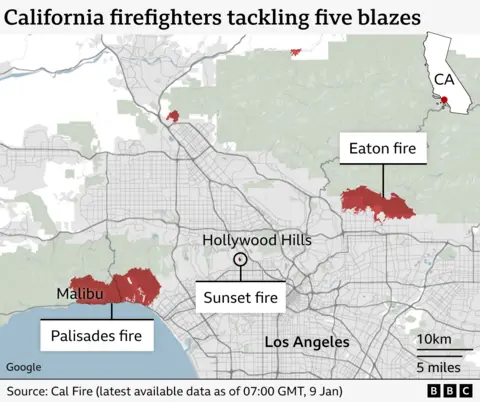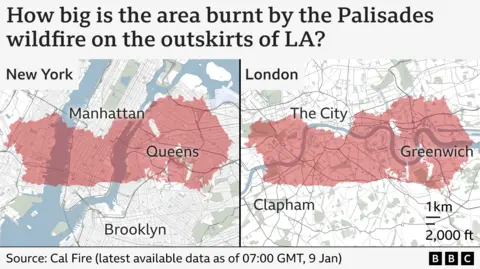What's the latest on the Los Angeles wildfires, and what caused them?
Out-of-control wildfires are ripping across parts of Los Angeles, leading to at least five deaths, burning down hundreds of buildings, and prompting evacuation orders for more than 179,000 people across the county.
Despite the efforts of firefighters, the biggest blazes remain totally uncontained - with weather conditions and the underlying impact of climate change expected to continue fanning the flames for days to come.
What's the latest?
In Los Angeles County, roughly 179,783 residents are under evacuation order - many of them leaving their homes simply carrying whatever belongings they can. Another 200,000 residents are under evacuation warning, meaning they could be required to leave their homes soon.
Police say at least five people have died, with their bodies found near the Eaton fire - but their cause of death is not yet known.
Los Angeles County Sheriff Robert Luna said he expected the death toll to rise, adding that a more thorough investigation needs to be done in the affected areas which, he said, "look like a bomb was dropped in them".
Looting and theft has risen in some evacuated neighbourhoods, Sheriff Luna said, leading to 20 arrests.
Like the even larger Palisades fire, the Eaton fire remains totally uncontained.
Meanwhile, the Sunset fire that has been menacing the well-known Hollywood Hills area has started to shrink but is not yet contained. Evacuation orders for the Hollywood Hills West area have been lifted.
Nearly 2,000 structures are known to have been destroyed - including houses and schools, and businesses on the iconic Sunset Boulevard. A fire ecologist has told the BBC that "entire neighbourhoods... have been wiped out".
Among the celebrities who have lost their homes are Leighton Meester and Adam Brody, who attended the Golden Globes just days ago, and Paris Hilton.
The insurance industry fears this could prove to be one of the costliest wildfire outbreaks in US history, with insured losses expected above $8bn (£6.5bn) due to the high value of properties in the paths of the blazes.
There is a glimmer of hope for firefighters, as the fire weather outlook for southern California has been downgraded from "extremely critical" to "critical".
But BBC weather forecaster Sarah Keith-Lucas says there is no rain forecast in the area for at least the next week, meaning conditions remain ripe for fire.
Power has been cut to swathes of the city, and traffic jams have built up. Adding to the disruption, a number of schools and the University of California, Los Angeles (UCLA) have been forced to close.
A political row about the city's preparedness has erupted after it emerged that some firefighters' hoses have run dry - an issue seized upon by US President-elect Donald Trump.
Where are the fires?

There are at least five fires raging in the wider area, according to California fire officials early on Thursday:
- Palisades: The first fire to erupt on Tuesday and the biggest fire in the region, which could become the most destructive fire in state history. It has scorched a sizable part of land, covering more than 17,200 acres, including the upscale Pacific Palisades neighbourhood
- Eaton: It has struck the northern part of Los Angeles, blazing through cities such as Altadena. It's the second biggest fire in the area, burning around 10,600 acres
- Hurst: Located just north of San Fernando, it began burning on Tuesday night and has grown to 855 acres, though firefighters have had some successlimited in containing it
- Lidia: It broke out on Wednesday afternoon in the mountainous Acton area north of Los Angeles and grew to cover almost 350 acres. Authorities say it has been 40% contained
- Sunset: It broke out Wednesday evening in Hollywood Hills, growing to about 20 acres in less than an hour. It covered around 43 acres but is now starting to shrink
The earlier Woodley and Olivas fires have now been contained, according to local fire authorities.
How did the LA fires start?
Officials have pointed to high winds and drought in the area, which has made vegetation very dry and easy to burn.
For the moment, officials have said the cause of the fires remains unknown and continues to be under investigation.
The probable impact of climate change has also been cited - although the exact circumstances remain unclear.
Some 95% of wildfires in the area are started by humans, according to David Acuna, a battalion chief at the Californian Fire Service, although officials are yet to state how they think the current fires started.
An important factor that has been cited in the spread of the blazes is the Santa Ana winds, which blow from inland towards the coast. With speeds of more than 60mph (97 km/h), these are believed to have fanned the flames.
What role has climate change played?
Although strong winds and lack of rain are driving the blazes, experts say climate change is altering the background conditions and increasing the likelihood of such fires.
US government research is unequivocal in linking climate change to larger and more severe wildfires in the western United States.
"Climate change, including increased heat, extended drought, and a thirsty atmosphere, has been a key driver in increasing the risk and extent of wildfires in the western United States," the National Oceanic and Atmospheric Administration says.
And following a very warm summer and lack of rain in recent months, California is particularly vulnerable.
Fire season in southern California is generally thought to stretch from May to October - but the state's governor, Gavin Newsom, has pointed out earlier that blazes had become a perennial issue. "There's no fire season," he said. "It's fire year."
Speaking to the BBC, Mr Acuna said the Palisades Fire represented only the third occasion in the past 30 years that a major fire had broken out in January.

Have you been affected by the fires in California? Get in touch here.

Sign up for our Future Earth newsletter to get exclusive insight on the latest climate and environment news from the BBC's Climate Editor Justin Rowlatt, delivered to your inbox every week. Outside the UK? Sign up to our international newsletter here.
